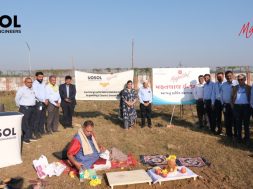
Seven tenders for a total of 84 megawatt-hours have now been issued.
India is finally seeing the emergence of a grid-scale energy storage market after years of anticipation.
This month the Solar Energy Corporation of India (SECI) invited bids for 3.6 gigawatt-hours of storage connected to 1.2 gigawatts of solar on India’s interstate transmission system, the biggest battery solicitation seen in the country so far.
The auction came hot on the heels of several other SECI solicitations. Also this month, SECI put out a call for two 150-megawatt-hour battery systems to be connected to 100-megawatt solar farms in Andra Pradesh.
Last month, meanwhile, saw SECI calling for a 42-megawatt-hour battery system to go with 14 megawatts of solar in Ladakh in northeast India.
The corporation also requested bids for a 20-megawatt floating PV plant in Lakshadweep, an archipelago off the southwestern coast of India, with 60 megawatt-hours of battery storage.
“These tenders will boost energy storage deployments up in next few years,” observed Le Xu, senior research analyst at Wood Mackenzie Power & Renewables.
The SECI auctions come on top of seven storage tenders in the last year, Bridge to India, a New Delhi-based analyst firm, said last month.
Those tenders were issued by SECI and the utilities NLC India and National Thermal Power Corporation (NTPC), and amounted to 84 megawatt-hours of capacity, tied to 78 megawatts of solar PV.
They were predominantly destined for solar plants in remote areas such as Jammu and Kashmir, Lakshadweep and Himachal Pradesh, Bridge to India said. For many observers, it’s about time India’s energy storage market got underway.
“India has massive solar and wind deployments since 2010, but the grid-scale energy storage market still remains untapped,” noted Xu.
The first three tenders
The country has been launching grid-scale energy storage tenders since 2017. But until recently the attempts to bring large-scale batteries to India were mostly ill-fated.
The first three utility-scale energy storage tenders, issued by SECI and NTPC with an aggregate capacity of 35 megawatt-hours, were canceled without explanation.
In 2017, SECI tried again with a 28-megawatt-hour battery plant in the Andaman and Nicobar Islands, for NLC India. The NLC India project, which is due for commissioning this April, was widely reported as being the first utility-scale energy storage plant in the country.
However, that honor likely belongs to a 10-megawatt joint project by Mitsubishi and the U.S. energy storage company AES, commissioned and operated by Tata Power Delhi Distribution.
The 10-megawatt-hour Advancion system went live last month in New Delhi to provide grid stabilization, improve peak load management, add system flexibility, enhance reliability and protect critical facilities, said battery vendor Fluence in a press release.
The recent rush to add energy storage to renewable plants is most likely a reaction to growing grid congestion as India seeks to place more and more solar and wind generation on already creaking electricity networks.
India has a target of installing 175 gigawatts of solar and wind by 2022. The country will most likely fall short. But even achieving 76 percent of this, as analysts expect, will be a major achievement — and will add to the strain on grid infrastructure.
Battery gigafactories
National elections in May this year are not expected to greatly change the outlook for renewables, Wood Mackenzie said. This might be expected to boost demand for energy storage, which is becoming increasingly competitive as the cost of lithium-ion batteries falls.
At the same time, Indian manufacturing concerns are keen to gain a foothold in the fast-growing battery market.
This month, Prime Minister Narendra Modi’s cabinet approved a National Mission on Transformative Mobility and Battery Storage, under which two phased manufacturing programs will be introduced across the country.
The first of these will support the setting up of battery gigafactories across India, while the second will focus on electric vehicle manufacturing.
The announcement came shortly after the Andhra Pradesh Economic Development Board and solar and battery manufacturing firm Urja Global signed a memorandum of understanding to make lithium-ion batteries and electric vehicles.
The initiative will see Urja Global investing ₹2 billion ($28.55 million) in manufacturing centers across Andhra Pradesh, Mercom India reported.












